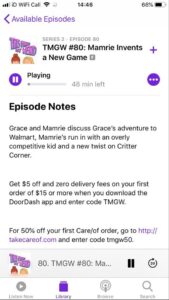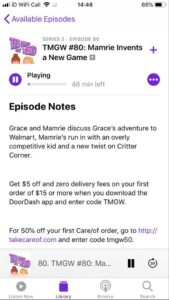 The online podcasting space is a playground for creators to innovate, connect and influence. What was once an underground movement is now an oversaturated market of opportunity for brands to speak to their customers directly. The development and global reach of podcasts continue to show how digital-first talent can create a streamlined partnership between their unique content and a brand, leading to what can be a successful revenue stream for both parties. However, with the widespread belief that “everyone has a podcast”, the challenge becomes how to stand out, create distinctive formats and effectively position sponsors within podcasts. It is important to note how podcasts can give a voice to smaller companies and niche markets in a succinct way. Conversations around branded partnerships on podcasts have escalated as the combination of creativity, a new platform and a new audience is increasingly attractive to brands.
The online podcasting space is a playground for creators to innovate, connect and influence. What was once an underground movement is now an oversaturated market of opportunity for brands to speak to their customers directly. The development and global reach of podcasts continue to show how digital-first talent can create a streamlined partnership between their unique content and a brand, leading to what can be a successful revenue stream for both parties. However, with the widespread belief that “everyone has a podcast”, the challenge becomes how to stand out, create distinctive formats and effectively position sponsors within podcasts. It is important to note how podcasts can give a voice to smaller companies and niche markets in a succinct way. Conversations around branded partnerships on podcasts have escalated as the combination of creativity, a new platform and a new audience is increasingly attractive to brands.
With wide-ranging genres and topics, podcasts are increasingly pertinent in the media world to compete with the constant production of online content. The new wave of podcasting has increased the number of online places you can go to for information. There is an unlimited possibility for people to learn from others. The function of a podcast does not always have to be educational; most are far from it. Many comedians have turned to podcasts as a way to showcase their best work, edited in a way in which suits them. There are very few unedited, raw podcasts as producers lean towards a more stylishly finished piece with soundbites, clean-cut features and intro/outro music. All these different styles could look to integrate a brand partner that matches the themes and tones of the conversations.
YouTube once acted as the progressive powerhouse, a petri dish of creativity. It was an evolutionary form of “edutainment”. Too many podcasts jumping out of our screens every day may suck the creative content out of the world if every comedy duo around starts to host their own weekly conversational podcast. The sponsored messaging within podcasts must continue to evolve and represent current climates and global situations. Both brands and hosts of podcasts must work together to design creative, relatable and concise ad breaks within the episodes. We are living in a world of constant search to experience real-life through a virtual form, whether that be via audio or video. We are also becoming more distracted, 64% of young people are “online” when watching TV (Social Chain, 2018). This means that podcasts must move with the times and speak to their audiences honestly and authentically, becoming more creative with every change they make in order to maintain our attention.
New forms of immaterial, digital labour envelope our everyday lives. Podcasting can be a form of labour in which you are constantly immersed. In order to network and succeed, you could always record one more episode, the belief being that the risk of becoming irrelevant is managed through social connections. What must be avoided is the tragic love story of creativity and success. Creative media appeals to those with a forward-looking vision. Listeners could be described as the “losers that keep waiting to be seen”, the dreamers amongst us that place value on positivity. Podcasters can weaponise nostalgia, hitting us with anecdotes, comedy sketches and old-school ways of living, allowing escapism from the real world. If a brand can produce messaging and continuously engaging information via an ad read, listeners will return for more and be more likely to investigate the product or service being advertised and brands can ensure the value is felt with full effect.
Film and television often represent historical standards of unfair representation and social norms, whereas podcasts by new wave millennials advocate more activism in the media industry to encourage inclusive, multi-faceted and ambitious creations. The influence on attitudes via audio-visual communication and advertising can be staggering. Challenging conversations lead to progression. This activism will increase the integrity of creative industries. It is interesting to evaluate the difference in influence between mainstream television and radio programmes and new media. Presenters of television and radio can often feel detached from their audience. Particularly when working with unbiased corporations, where they’re unable to promote or discuss any of their own opinions. This means that the audience, although engaging in their millions, does not know anything about the personal life of the person they are watching. They are not invested in their lives. They have no attachment. In contrast, digital-first talent has amassed their following by being open and honest online and giving their truthful opinions on everything ranging from food to politics to veganism. In the current climate of hedonistic lifestyles, it is unsurprising that online social media talent can influence audiences more than mainstream media. Taking this into consideration, it could be confidently suggested that partnering with podcasts is a great way to reach new audiences and provide clear explanations of what a certain brand may offer.
As podcasts provide copious amounts of content with the offer of inspiration, ideas and advice to make business and life decisions, they can be incredibly influential. You feel connected to a person through headphones, carrying out active listening such as nodding your head, laughing or verbally agreeing with someone that is not physically there. It is an exciting time for brands to be involved with a new wave of creative entrepreneurs that are using a simple medium to build global connections around the world. Podcasts whether they be educational, comical, fiction or everything in between bring people together in a shared moment of relatability. Quick and easy listening styles of podcasts sponsorships leave people wanting more and the content can be made personal to all listeners. Brands should be on the lookout for a podcast partner that matches their brand values and demographic, as it will enable them to reach a new audience using a creative and effective ad format.
